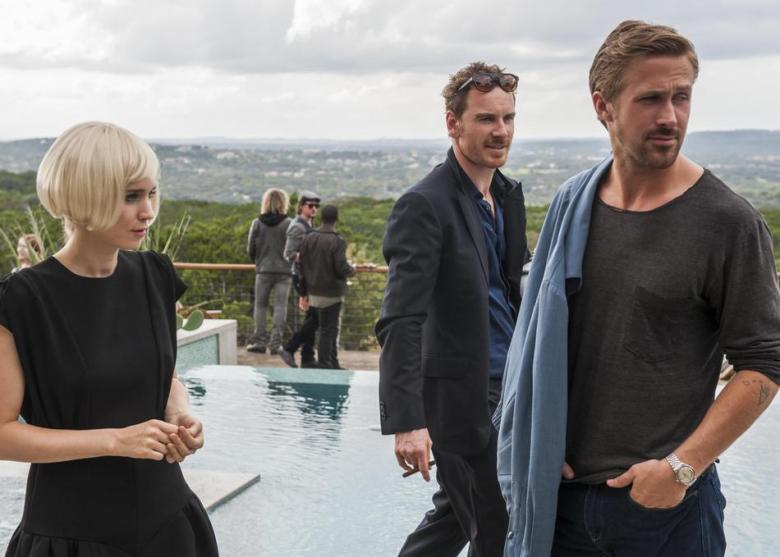Terrence Malick released Song to Song, his long-delayed, seemingly apocryphal movie about the Austin music scene, at an awkward time. The trailers started rolling out while Damien Chazelle’s La La Land–also starring Ryan Gosling as a struggling, piano-playing musician–was still enchanting and irking the moviegoing world in equal parts. Superficial trappings aside, the movies aren’t anything alike; one of them is made by Terrence Malick, after all, whose films generally don’t resemble other people’s. In Song to Song, Gosling plays “BV,” another struggling singer-songwriter who wears V-necks instead of swing-revival dress wear. But he doesn’t play any jazz, or at least we don’t know, because he plays very little music in the movie. In fact, the actual music has seemingly little to do with Song to Song, which takes place largely in the transitional “to” space of its title, and bears all of the most frustrating hallmarks of a Terrence Malick movie with little of his former charm or resourcefulness.
Song to Song begins with a breathy, overwrought voiceover by Rooney Mara, who stars alongside Gosling as Faye, another aspiring musician who’s dropped out of respectable professional life and estranged herself from her family. She becomes BV’s girlfriend, but continues to sleep with his erstwhile best friend, sleazy but well-connected record man Cook (Michael Fassbender). “I thought sex was supposed to be dangerous,” Mara murmurs over the film’s opening frames, as she rolls around in bed with the chiseled Fassbender. Later on, she clarifies: “I thought it would bring me closer to life.” This is, in some incredibly ill-defined sense, the trajectory of Song to Song: a troubled coming-of-age story about a young female artist pursuing her dreams, and losing track of herself in the process.
But the real story Song to Song tells is Malick’s: his quest to piece a comprehensible film together, a struggle that lasts the entire film. In his veritable golden days–now some forty years past–Malick’s signature was jumbling elements of a fairly simple story to tell it in a unique, innovative way, using tools that only the language of movie-making could afford him. In his signature films Days of Heaven and Badlands, flashbacks were folded into his “present” timelines without warning; characters’ narrative perspectives were juggled freely; detached audio from another scene played over unrelated visuals (rural vistas, often). It felt like Malick was taking rich, trenchant narratives and scrambling them–detaching the component formal conventions of Hollywood cinema from one another and layering them on top and alongside each other in all sorts of unlikely ways.
Decades later, the reborn Malick of The Tree of Life was recognizable, but had new obsessions. He now seemed to want to make movies that were about everything, and the perspective was more expressly psychedelic than in his formative films. Amidst Tree of Life’s decadent, Kubrickian sprawl, improvisation within emotional scenes enhanced the concept, creating a fractured and poignant portrait of a boy growing up. Whether or not you thought that scene with the dinosaurs was charming or dumber than sin, it was hard to dispute that Malick’s comeback film looked like little that had come before it.
In Song to Song, as well as last year’s misbegotten Knight of Cups, it feels like Malick is banking on some Tree-of-Life-like mystical synergy that never materializes. The film consists mostly of duos or trios of the main quartet of characters–Mara, Gosling, Fassbender, and Natalie Portman as his wife Rhonda, a local woman he met while she was waiting tables at a diner–meandering in stray corners of the Austin metropolitan area: parking lots, campuses, taco stands, underneath freeway bridges, behind South by Southwest stages. Why are they there? We rarely know, and it never matters. They stage odd ballets, murmuring lines (presumably of their own invention) sometimes unintelligibly, pausing to kiss each other’s bellies at random. Ah, youth! Malick seems to be crying out, again and again, sometimes with a slightly chiding tone.
Whatever else he’s trying to say, however, often feels unclear. Malick leaves his resourceful cast to construct characters and conflict from whole cloth, seemingly without an endgame in mind. Voiceovers, contributed by the four major characters, are dialed in to impose some sort of linear narrative of Malick’s erratically-edited daisy chain of half-scenes. These interjections fall into two major categories: A. Let me describe what the emotional heft of this scene needs to be for the plot to work and B. Let me just bring you up to speed on what’s going on. They provide inelegant signposts along the film’s troubled journey, defining each of the four leads’ downward spirals as ambition, off-brand drugs, orgies, and greed for oversized cuts of royalties get the best of them and destroy their relationships.
The promise of a litany of oddball musician cameos in the previews might make it seem like Song to Song’s milquetoast central plot would be offset by some fun, weird moments of spectacle. Even on this front, however, Malick’s film disappoints. Not even a shaggy, soul-patched Val Kilmer (character nameless, bellowing incomprehensibly) sawing an amp apart or Michael Fassbender wrestling Flea and Anthony Kiedis can redeem Malick’s narrative water-treading. Some of the cameos, in fact, actually compound the film’s problematic themes. Patti Smith, who has sort of an extensive speaking role, shows up at several points to preach to Mara’s character to reminisce about past loves and espouse the importance of “fighting for your man.” These scenes, like most of the half-conversations in Song to Song, serve little to no functional purpose in the narrative, or even in the character-creation process.
Defenders of late Malick enjoy the visceral power of his cinematic language, but for a film that revolves so much around torrid romance and sexual hunger, Song to Song is decidedly unsensual. It also feels surprisingly conservative, from a moral perspective. Mara’s character’s entire search seems to be for a life of quiet stability in a relationship with a stable (male, mind you) partner (golden, blonde-haired hunk Gosling, of course). She wonders at the beginning of the film if is sex supposed to be dangerous, but ultimately, she realizes, it isn’t: It’s supposed to be boring. At its wildest, it should happen in a rustic kitchen in the middle of stirring pasta or making mole or whatever. As it does for everyone, the time eventually comes when Faye has to stop going to afterparties DJed by Diplo and get down to having a family.
Side characters emphasize Malick’s regressive themes: Most notably, there is a hooker-with-a-heart-of-gold character–hired for a threesome with Fassbender and Portman–who discusses how mortified she is by her current profession, which she took up after the passing of her husband, the apparent bedrock of her household. This would-be cautionary tale is as unnecessary as it is corny. Indeed, no female character in this film seems to be able to carry on happily for very long without a good man on their arm. Portman’s relatively-minor character also ultimately serves an questionable, cartoonish function in the film: becoming a casualty of the raw male id as embodied by Fassbender, who’s perpetually dressed like a villainous rockstar from some late-’90s cyberpunk thriller. It’s worse because it feels like all these unfortunate devices are just a byproduct of Malick’s lack of roadmap for Song to Song, not the result of any concerted attempt at articulating a cogent view of the more turbulent side of human nature and sexual dynamics.
Ultimately, Song to Song comes off a bit like some jilted male lover’s jealous, fantastical imaginings of their selfish ex’s life without them: jumping into other men’s beds on a whim, thinking only about herself until she finally sees the error of her ways. These are lives glimpsed rather than explored; we leave the film feeling both like we’ve seen too much of these characters and that we don’t know them at all. Malick has always taken risks with plot idiosyncrasies, characters who don’t correspond logically from scene to scene, and of course, far-flung levels of pretension. But in his best moments, these added up, pointed to, or meant something; you didn’t have to like everything in Tree of Life to recognize it as a bold and singular achievement. But in Song to Song, the director makes quick work of rendering his larger vision–touching on every element of the human psyche, perhaps–inaccessible to the viewer. Malick’s movie functions like a forest hunting trap Martin Sheen might have laid in Badlands: elaborate, distracting latticing on the surface barely obscuring the deadly, empty abyss beneath.





